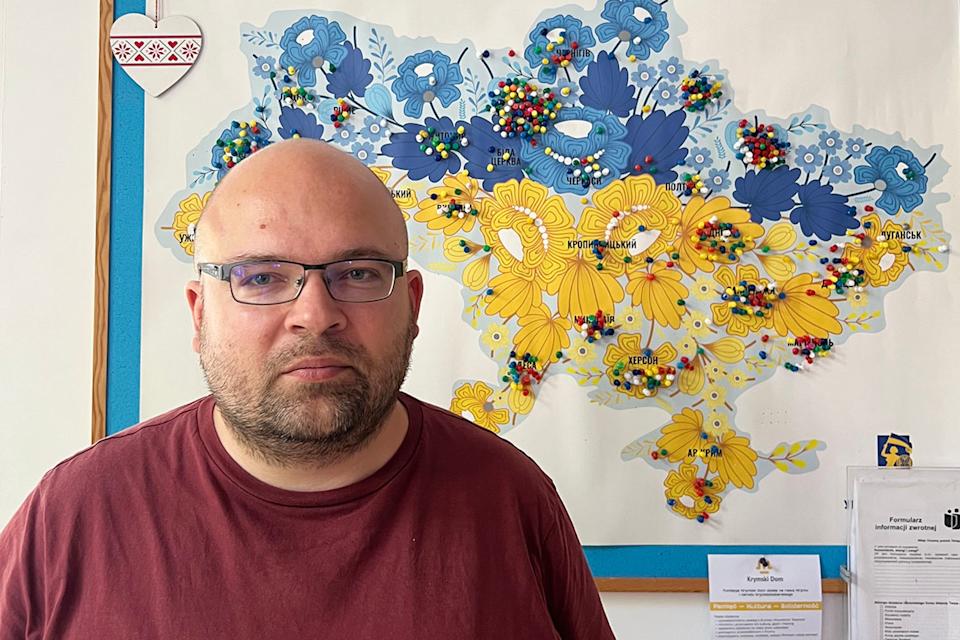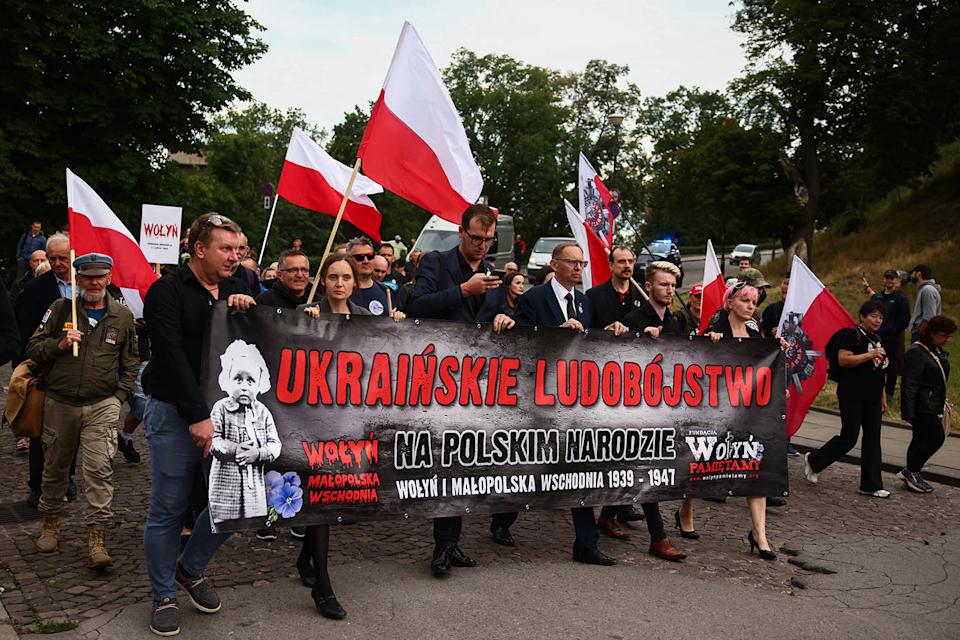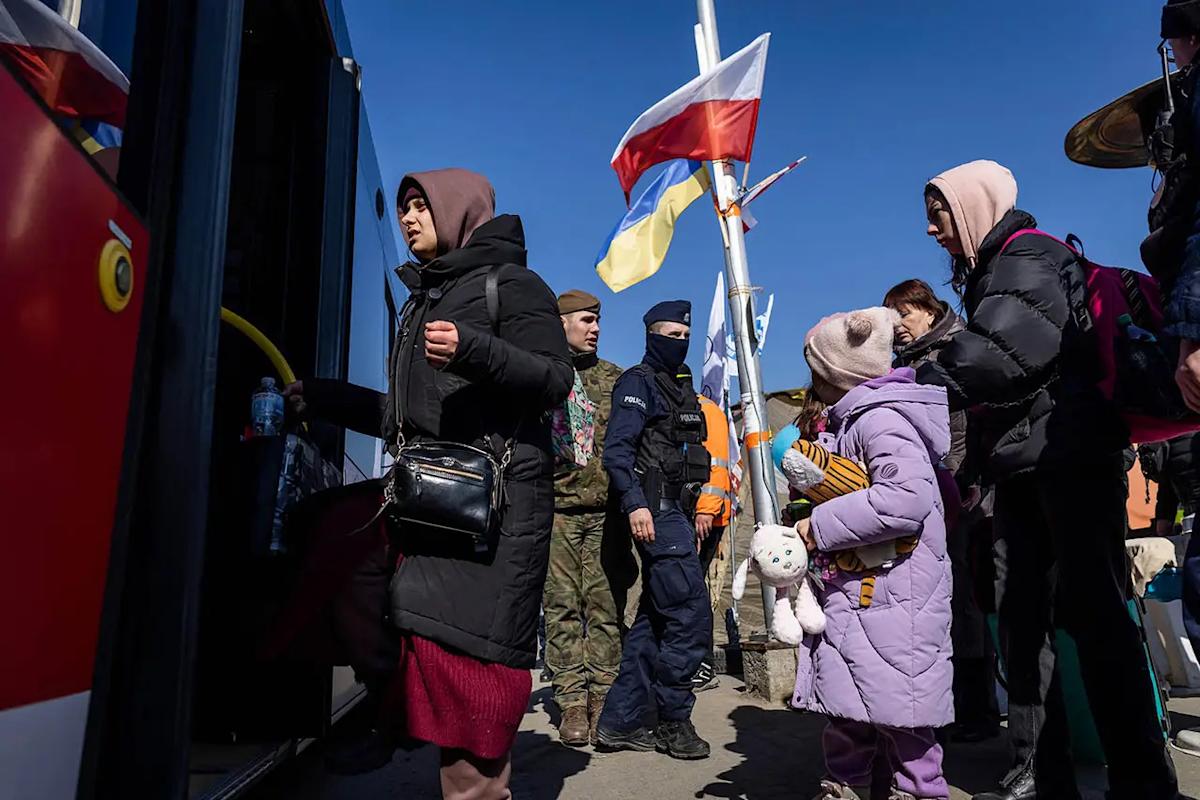Since arriving in Poland three years ago, Vladyslav, a 28-year-old Ukrainian man, has gone from one odd job to another: cleaning, car washing and warehouse work before landing a shelf-stacking job in a supermarket in the town of Ząbki, a few miles east of Warsaw.
Originally from Izium, in eastern Ukraine, he left home six months into the war to avoid compulsory military service. “I didn’t want to take up arms, to kill, and to fall deeper into depression,” he explains in hesitant Polish, brushing back his blond fringe, as he restocks the sweets aisle.
Vladyslav was one of 1.4 million Ukrainians who fled across the border into neighbouring Poland in the weeks and months after Russia launched its full-scale invasions in February 2022.
At first they were greeted with open arms. Poles organised humanitarian convoys to the border, welcomed refugees in railway stations, and offered shelter to families. “We will welcome all those in need,” Polish president Andrzej Duda promised with solemn conviction on 4 March 2022, speaking from the Polish-Ukrainian border, as long queues of people fleeing war stretched behind him, along the crossing.
If there was one issue capable of securing cross-party support amid an intensely polarised political landscape, from Jarosław Kaczyński’s nationalist Law and Justice party to prime minister Donald Tusk’s liberal Civic Platform, it was the framing of the Kremlin as an existential threat.
‘A customer asked why I wasn’t on the front line, and my sister is ignored by her classmates because of her accent’
Since then attitudes have hardened. Today, 38% of Poles say they feel an aversion towards Ukrainians, with only 30% holding a positive view of them. That marks a drop of 10 percentage points from the previous year, and 21 points compared with 2023.
Three years after the war broke out on its doorstep, Poland, Ukraine’s neighbour, is grappling with tensions over refugee management and the challenge of integration.
“One day a customer asked me why I wasn’t on the front line,” Vladyslav says with a sigh. His sister, who also moved to Poland and is studying at a computer science school in nearby Zielonka, is “ignored by her classmates because of her accent”, he says. He also reveals the toll online hate speech takes on his wellbeing, as aggressive social media comments against Ukrainians grow more radical.
Stereotypes about Ukrainians have endured, a painful history continues to divide the two nations and radical far-right politicians denounce a “Ukrainisation” of Polish society.
“The honeymoon is over for the refugees who arrived in 2022,” sums up Oleksandr Pestrykov, an expert at Warsaw’s Ukrainian House, a foundation promoting integration and dialogue.

39099.jpeg
Part of the reason is that the atmosphere towards migration more broadly has changed, too. During the recent presidential campaign, Karol Nawrocki, the eventual winner, pledged to give priority to Polish citizens waiting for medical procedures. Activists also fear that the monthly child benefit of 800 Polish zloty (about £160) could be restricted for foreigners and that the residency period required to obtain Polish citizenship will be extended.
In March, Tusk suspended the right to seek asylum at Poland’s eastern border with Belarus. He also launched an online campaign urging migrants from Africa and the Middle East to stay in their home countries. Earlier this month, facing pressure from nationalist activists who accuse Germany of pushing some of its migrants back into Poland, Warsaw reinstated border controls with Germany and Lithuania, suspending Schengen free movement at those crossings. The radicalisation of political rhetoric around immigration worries Pestrykov, as “Ukrainians inevitably feel its impact, too”.
However, Poland, with one of the lowest birth rates in the European Union, cannot afford to lose this workforce. “Ukrainians often take on low-skilled jobs in industry or services, sometimes below their qualifications,” explains Mateusz Walewski, chief economist at the state-owned Bank Gospodarstwa Krajowego.
For the Polish economy, this is an advantage. But in the long term, Walewski argues, “real social mobility is essential for refugees to settle permanently”. (Vladyslav was an IT programmer in Ukraine.)
According to a recent report by Walewski, Ukrainians contribute between 0.5% and 2.4% to Poland’s annual GDP growth. And for every zloty spent on Ukrainian children through family benefits, 5.4 zloty returns to the state in taxes and social contributions. In fact, 93% of Ukrainians who arrived before the war and 68% of those with refugee status are employed – the highest figure among host countries.

39193.jpeg
These are just a few pieces of data that contradict online misinformation, often spread by nationalist circles, including the far-right Confederation party, now the third-largest political force in Poland, which portrays Ukrainians as a major burden on public finances.
Historical wounds also play their part. The Volhynia massacres, carried out between 1943 and 1945 by the Ukrainian Insurgent Army, killed tens of thousands of Poles as part of an ethnic cleansing operation aimed at preparing the creation of an independent Ukrainian state. Nawrocki, a historian by training, has called on Ukraine to implement “a systemic solution to locate and exhume the victims’ remains”. Failure to do so could jeopardise Ukraine’s accession to the EU and Nato, warns this rising figure of the Polish sovereigntist right.
The issue has seeped into public debate for years, fuelling tensions and shaping public opinion. “A few months ago, after hearing me speak Ukrainian, passers-by told me they remembered what happened a century ago,” says Dima, a 23-year-old bartender in Wrocław.
While employment is a driving force facilitating contacts between Poles and Ukrainians, deeper friendships remain harder to form. The limited interactions outside the workplace strengthen the feeling of social exclusion. In 2022, 83% of Ukrainians held a favourable view of Poles. By November 2024, that figure had dropped to just 41%.
In major cities, it is easy to get by speaking only Ukrainian at such places as the dentist or hairdresser, and sometimes even with colleagues. “It’s quicker and more natural,” shrugs Vladyslav, who points at his Ukrainian colleagues, walking between supermarket aisles. “It could deepen divides,” warns Pestrykov.
Although the number of Ukrainian refugees in Poland has remained stable over the past two years, nearly half admit they are unsure whether they want to stay longer term.
Despite the uncertainty, for those who want to stay there is one clear advantage. “What matters most to us is that the bombs are no longer falling on our heads,” says Pestrykov.
Photographs by Wojtek Radwanski/AFP, Adam Hsakou/The Observer and Beata Zawrzel/NurPhoto via Getty
